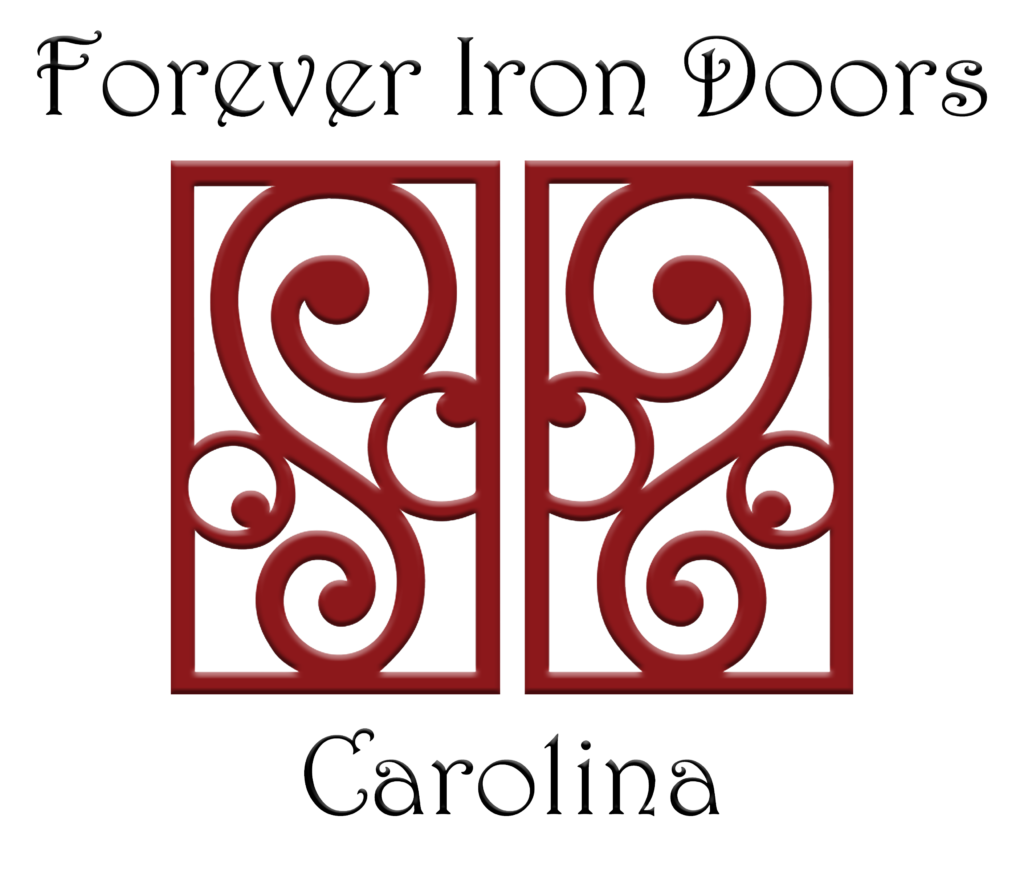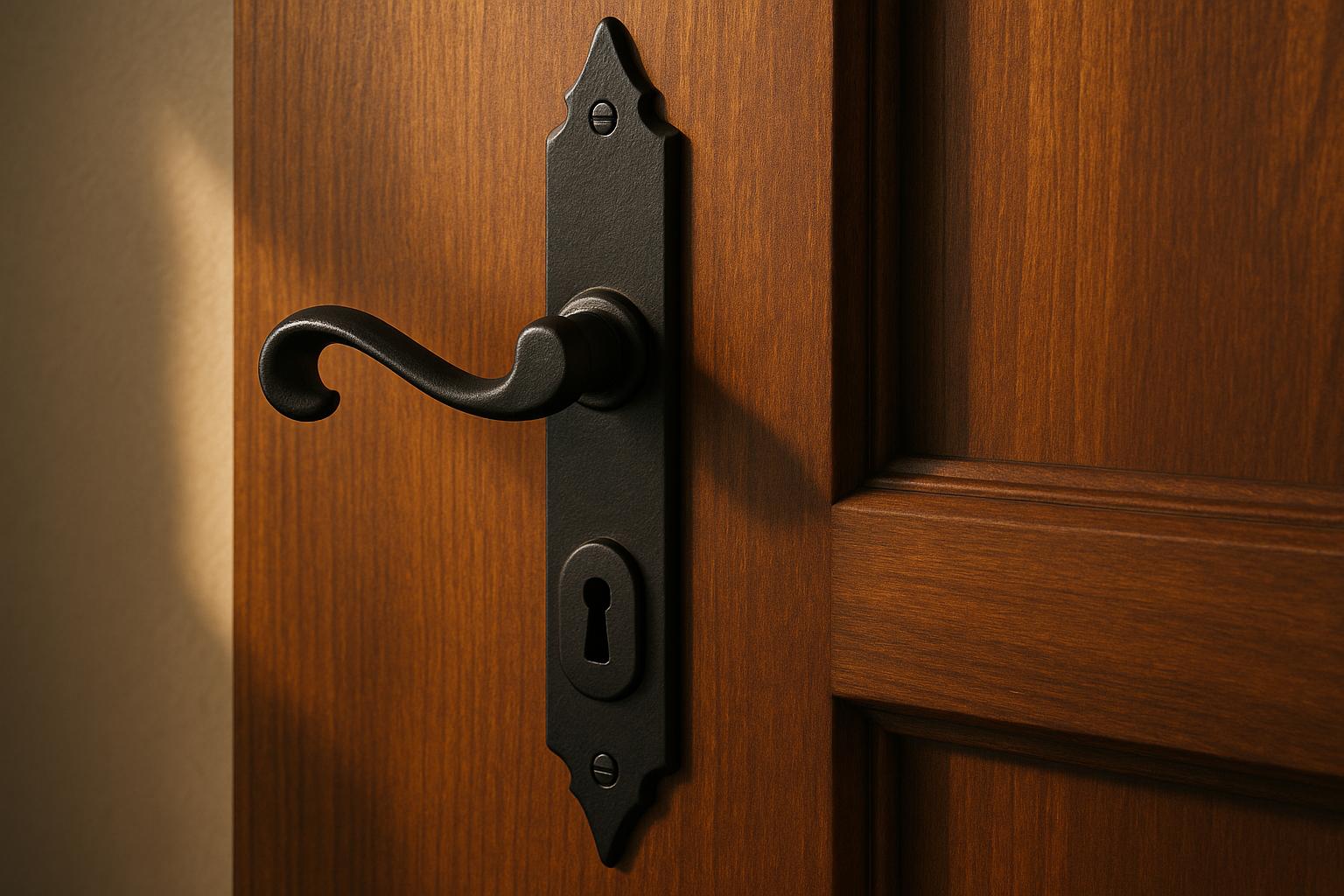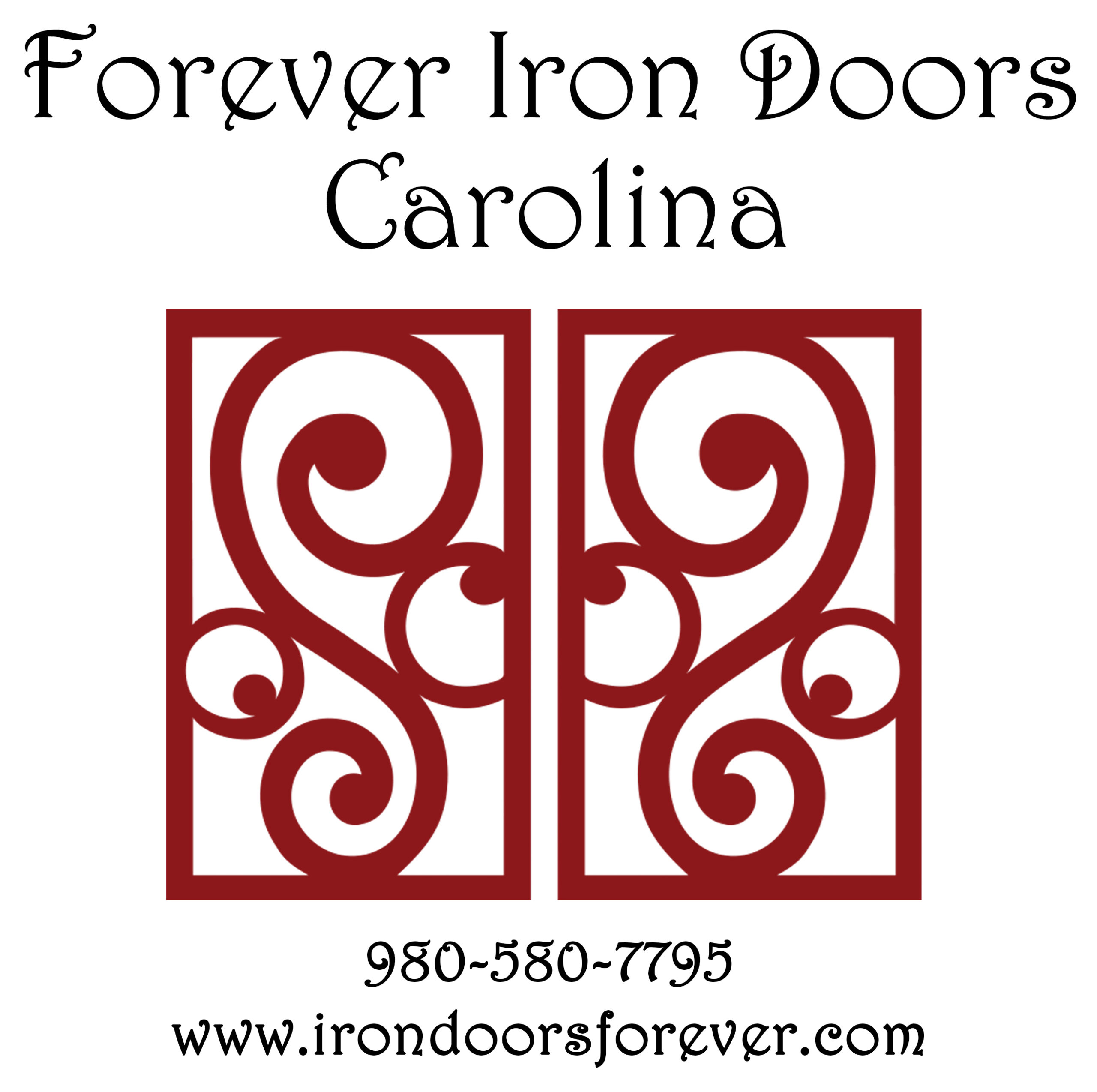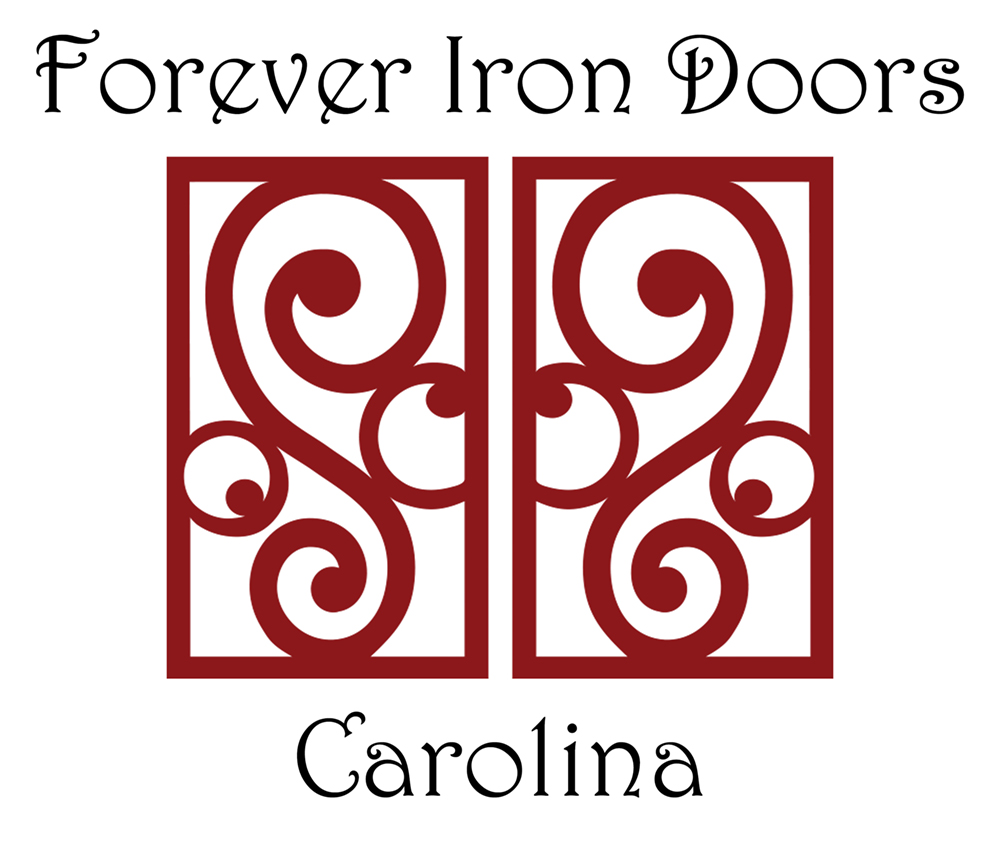When choosing a finish for wrought iron door hardware, consider both style and practicality. The right finish protects against rust, enhances durability, and complements your home’s design. Here’s a quick breakdown of three popular options:
- Matte Black: Bold and modern with low maintenance. Hides fingerprints and minor scratches but may fade under strong sunlight.
- Bronze: Warm and classic, develops a patina over time. Durable but requires regular upkeep to maintain its look.
- Brushed Nickel: Sleek and neutral, works with most styles. Easy to clean and resists tarnishing but lacks bold visual impact.
Quick Comparison
| Finish | Style | Durability | Maintenance | Best For |
|---|---|---|---|---|
| Matte Black | Modern, bold | Resists chipping, fading | Low (occasional wiping) | Modern, industrial, farmhouse |
| Bronze | Warm, evolving patina | Long-lasting, resists rust | Medium (regular cleaning) | Mediterranean, rustic, historic |
| Brushed Nickel | Neutral, polished | Tarnish-resistant | Low (simple cleaning) | Contemporary, transitional, colonial |
Your choice depends on your home’s style, climate, and maintenance preferences. For a bold statement, go with matte black. If you love aged charm, bronze is ideal. For a sleek, low-maintenance option, brushed nickel is the way to go.
1. Matte Black
Matte black brings a modern and bold aesthetic that stands out effortlessly. Its non-reflective surface adds depth and elegance while doing a great job of hiding fingerprints and minor scratches, making it a practical yet stylish choice.
Aesthetic Qualities
Matte black offers a rich and striking appearance that works as both a neutral backdrop and a standout feature. Its light-absorbing surface creates a velvety, high-end look that feels substantial and refined.
This finish pairs beautifully with modern design elements like wood, stone, and industrial features such as exposed brick or concrete. Thanks to its non-reflective surface, matte black doesn’t compete with other design elements but instead anchors the overall aesthetic with understated elegance.
These visual perks are complemented by its durability and ease of maintenance, making matte black a go-to option for many.
Maintenance Requirements
One of the advantages of matte black is its low-maintenance nature. Its textured surface naturally hides dust, water spots, and minor wear that would stand out on shinier finishes. A quick wipe with a damp microfiber cloth is usually enough to keep it looking pristine.
However, it’s important to avoid abrasive cleaners or tools like steel wool, as they can damage the surface and leave shiny spots that are hard to fix. Stick to mild soap and a soft cloth for cleaning. While matte black can show white residue from hard water, regular cleaning prevents buildup and keeps it looking fresh.
Durability
Matte black finishes are often created using a powder coating process, which results in a surface that resists chipping, fading, and corrosion. This method forms a strong bond, making it more durable than traditional paint or plating.
This finish is also built to withstand the elements. The dark color absorbs heat, helping to prevent moisture from lingering, while the textured surface offers better adhesion and protection compared to smooth finishes. With proper care, high-quality matte black finishes can maintain their look for 10-15 years.
Best Architectural Styles
Matte black hardware complements modern homes with clean lines and minimalist designs. It’s also a favorite in farmhouse and industrial styles, where its sleekness contrasts beautifully with rustic materials like wood and metal.
Interestingly, matte black works well with traditional homes too, adding a contemporary touch without overshadowing classic designs. Colonial and craftsman-style homes benefit from its ability to emphasize architectural details, while Mediterranean and Spanish-style properties use matte black to create dramatic contrasts against stucco walls and terra cotta features.
2. Bronze
Bronze finishes bring warmth, character, and a touch of sophistication to entryways. This timeless option offers a range of tones, from warm coppery hues to deeper, darker shades, creating a "living finish" that develops a story of its own through natural aging.
Aesthetic Qualities
Bronze hardware is anything but static. Its depth and tone shift subtly under natural light, creating a dynamic look that keeps the eye engaged.
This finish pairs beautifully with natural materials like stone, brick, and wood. It works especially well with warm color schemes, enhancing creams, beiges, and earth tones while adding richness to darker exteriors. Bronze also complements the texture of wrought iron, highlighting craftsmanship and intricate details in decorative features.
One of its most appealing traits is the patina it develops over time. This natural aging process gives bronze an authentic charm that synthetic finishes simply can’t replicate.
Maintenance Requirements
The beauty of bronze comes with some care requirements to preserve its intended look. Routine cleaning and a bit of attention can keep it looking its best.
For maintenance, use a soft cloth and a mild soap solution to clean the surface regularly. Harsh chemicals or abrasive materials should be avoided, as they can disrupt the patina or cause uneven coloration. If you prefer to slow down the aging process, applying a protective wax every 6-12 months can help maintain the original finish longer.
For those who embrace the antique look, the natural patina not only adds character but also serves as a protective layer, guarding against corrosion.
Durability
Bronze is more than just a pretty finish – its durability makes it a practical, long-term choice. Naturally resistant to corrosion, bronze holds up well in outdoor settings, even in harsh weather. The copper content in bronze forms a protective layer that helps prevent rust and deterioration.
With proper care, bronze finishes can last 15-20 years or more. The material itself is sturdy and resists daily wear and tear. Unlike painted finishes that may chip or peel, bronze retains its integrity even when scratched, as the color runs throughout the material. Over time, its natural patina not only enhances its appearance but also adds another layer of protection against the elements.
Best Architectural Styles
Bronze hardware is a natural fit for traditional and historic homes. Colonial, Victorian, and Tudor-style homes benefit from its timeless appeal, seamlessly blending with period elements.
Mediterranean and Spanish-style homes are another perfect match, as bronze’s warm tones harmonize beautifully with stucco walls, tile roofs, and wrought iron accents. Craftsman-style homes also pair well with bronze, as its artisanal qualities align with the emphasis on natural materials and handcrafted details.
Even modern homes can use bronze effectively. When balanced with other warm materials, bronze can soften contemporary designs, preventing them from feeling too cold or industrial. The key is to avoid overly cool color schemes that might clash with bronze’s inherent warmth.
3. Brushed Nickel
Brushed nickel brings a sleek and polished option to the table, offering a refined look that works effortlessly in both modern and classic settings.
Aesthetic Qualities
This finish is all about balance. Brushed nickel delivers a soft, understated shine – not too matte, not too reflective. Its brushed texture adds subtle depth without overpowering other design elements, making it a sophisticated choice for entryways.
One of its standout features is its versatility. Brushed nickel works well with both warm and cool color schemes, making it a go-to option for homeowners who love to refresh their exterior décor. Unlike the warmth of bronze or the boldness of matte black, brushed nickel acts as a neutral, enhancing architectural details while maintaining a clean, polished vibe.
Maintenance Requirements
If you’re looking for a finish that’s easy to care for, brushed nickel fits the bill. Its textured surface naturally hides water spots and fingerprints better than polished chrome or stainless steel, cutting down on maintenance. All you need to keep it looking great is a soft microfiber cloth and a simple soap solution.
The brushed texture also helps mask daily wear, making it a smart choice for busy entryways. Just steer clear of ammonia-based cleaners or abrasive materials, which can dull the finish. A quick weekly wipe is usually enough to keep it looking fresh and maintaining its subtle shine.
Durability
Brushed nickel is built to last. It offers strong protection against tarnishing and corrosion, especially when applied to durable wrought iron hardware. The nickel plating forms a barrier that stands up to the elements while keeping its appearance intact.
With proper care, brushed nickel hardware can maintain its refined look for 12-18 years. The brushed texture is also forgiving when it comes to minor scratches, ensuring your entryway hardware stays elegant even with regular use.
Best Architectural Styles
Brushed nickel is a natural fit for contemporary and transitional homes, thanks to its clean and sophisticated design. It’s also a favorite for modern farmhouse styles, where its subtle elegance ties together rustic and polished elements.
For traditional colonial or craftsman-style homes, brushed nickel enhances classic architectural details without stealing the spotlight. It pairs beautifully with neutral exteriors, stone accents, and mixed-material designs, offering a cohesive, understated hardware choice that ties everything together seamlessly.
sbb-itb-cd90297
Finish Comparison: Pros and Cons
When selecting the perfect finish for your wrought iron door hardware, it’s essential to weigh the advantages and disadvantages of each option. The finish you choose will not only influence the overall look of your entryway but also impact its durability and maintenance over time.
| Finish | Pros | Cons |
|---|---|---|
| Matte Black | Offers a timeless, versatile style that works with many architectural designs; hides fingerprints and water spots effectively; pairs well with both light and dark exteriors; creates bold, dramatic contrast. | Can attract dust and lint more easily; prolonged exposure to strong sunlight may cause fading; might feel too stark for certain traditional designs. |
| Bronze | Provides a warm, rich aesthetic; develops a natural patina over time, adding character; complements earth tones and natural materials; ideal for traditional or rustic styles. | Requires more frequent cleaning to maintain its appearance; patina may develop unevenly; higher maintenance demands; may not pair well with cooler color schemes. |
| Brushed Nickel | Sleek and modern, making it a great fit for contemporary and transitional homes; works with both warm and cool color palettes; low-maintenance and resistant to minor scratches; easy to clean. | Lacks the bold personality of bronze or matte black; may feel too neutral for designs aiming to make a statement; water spots can be more visible compared to textured finishes. |
Several factors, including durability, climate, style, and maintenance, can guide your decision when choosing a finish.
Durability and Environmental Considerations
Matte black is known for its sturdy performance, bronze develops a protective patina over time, and brushed nickel is naturally resistant to wear. However, the longevity of each finish depends on environmental conditions. For example, coastal areas with salty air may benefit from brushed nickel’s corrosion resistance. In regions with intense sunlight, bronze can handle UV exposure better than matte black, which is more prone to fading. Meanwhile, in damp climates, matte black’s ability to hide water spots becomes a practical advantage.
Style and Aesthetic Versatility
Matte black is a chameleon, fitting seamlessly into various styles from modern to industrial. Bronze adds warmth and depth, making it a favorite for Mediterranean or rustic designs. Brushed nickel, on the other hand, shines in contemporary and transitional spaces, offering a clean and polished look. Beyond protection, each finish allows homeowners to personalize their entryway, enhancing the overall aesthetic.
Maintenance and Cost Implications
Bronze requires consistent upkeep to maintain its evolving patina, while matte black typically only needs occasional dusting. Brushed nickel stands out for its low-maintenance nature, appealing to those who prefer a hassle-free option. Over time, bronze’s higher maintenance demands might lead to increased costs, whereas the simpler care routines of matte black and brushed nickel make them more budget-friendly in the long run.
Ultimately, your lifestyle and preferences will shape your choice. Busy households might lean toward brushed nickel for its practicality, while those who enjoy the charm of aging finishes may find bronze appealing. If you’re looking to make a bold visual statement, matte black is a striking option that delivers dramatic impact.
Conclusion
Finding the perfect finish for your wrought iron door hardware is all about balancing your design preferences with practical needs. Matte black is a bold, versatile choice for homeowners who want their entryway to stand out. Bronze brings warmth and character, with its patina evolving over time – perfect for those who appreciate an aged look and don’t mind a bit of upkeep. Meanwhile, brushed nickel offers a sleek, modern appearance with minimal maintenance, making it ideal for busy households seeking style and convenience.
Each finish has its advantages depending on your environment and lifestyle. For example, brushed nickel is a smart pick in coastal areas due to its resistance to corrosion. Bronze handles intense sunlight well, thanks to its UV durability. And in humid climates, matte black helps hide water spots, keeping your entryway looking sharp with little effort.
If you enjoy seeing how materials age and evolve, bronze’s patina adds ongoing charm. On the other hand, brushed nickel is perfect for those who prefer a low-maintenance option. Matte black sits comfortably in the middle, offering striking visual appeal with only occasional care.
At Forever Iron Doors Carolina, you’ll find a range of customization options to ensure your door hardware perfectly suits your home. Their expertise in crafting custom wrought iron doors, paired with professional installation services across North and South Carolina, guarantees your chosen finish will not only look stunning but also stand the test of time. Whether you’re drawn to the dramatic elegance of matte black, the timeless warmth of bronze, or the polished simplicity of brushed nickel, their team is ready to help you design an entryway that reflects your style and meets your needs.
A well-chosen finish does more than complete your door – it enhances your home’s curb appeal and creates a lasting first impression.
FAQs
What is the best finish for wrought iron door hardware based on my home style and climate?
When selecting a finish for your wrought iron door hardware, it’s important to think about both your home’s design and the climate in your area. For homes in humid or coastal regions, rust-resistant finishes like powder coating or zinc galvanization are excellent choices to help guard against corrosion. On the style front, finishes such as matte black, oil-rubbed bronze, and brushed nickel can seamlessly match a wide range of aesthetics, from rustic and traditional to sleek and contemporary.
For a combination of durability and visual appeal, finishes like wrought iron patina or powder coating offer reliable, long-lasting protection while enhancing the overall look of your entryway. Striking the right balance between practicality and style ensures your hardware finish will suit both your home and its environment.
What maintenance is required for different wrought iron hardware finishes, and how does it impact costs over time?
The upkeep requirements for wrought iron hardware finishes depend largely on the type of finish you choose. Painted or coated finishes generally need to be reapplied every 5–10 years. The cost for this maintenance can range from $200 to $1,000, depending on the size of the hardware and the method used. On the other hand, oil or wax finishes are less expensive initially but demand annual reapplication, making them more labor-intensive in the long run.
If you’re looking for a more lasting solution, powder coating stands out as a durable and cost-effective choice over time. While the initial investment might be higher, this finish requires very little maintenance, which can save you money and effort throughout the hardware’s lifespan. Selecting the right finish is key to balancing maintenance needs and long-term costs, keeping your hardware both practical and attractive.
Can I mix different finishes on wrought iron door hardware, and how do I make sure they look good together?
Yes, mixing different finishes on wrought iron door hardware can add a stylish and personalized touch to your space. To make it work, start by selecting one primary finish as the focal point, then add 1-2 complementary finishes for contrast. For instance, combining the warmth of bronze with the cool elegance of matte black or brushed nickel can create a visually balanced and appealing look.
Keep it simple by limiting the finishes to 2-3 maximum and distributing them thoughtfully throughout the area. This method brings depth and character to your entryway while keeping the overall design polished and harmonious.



